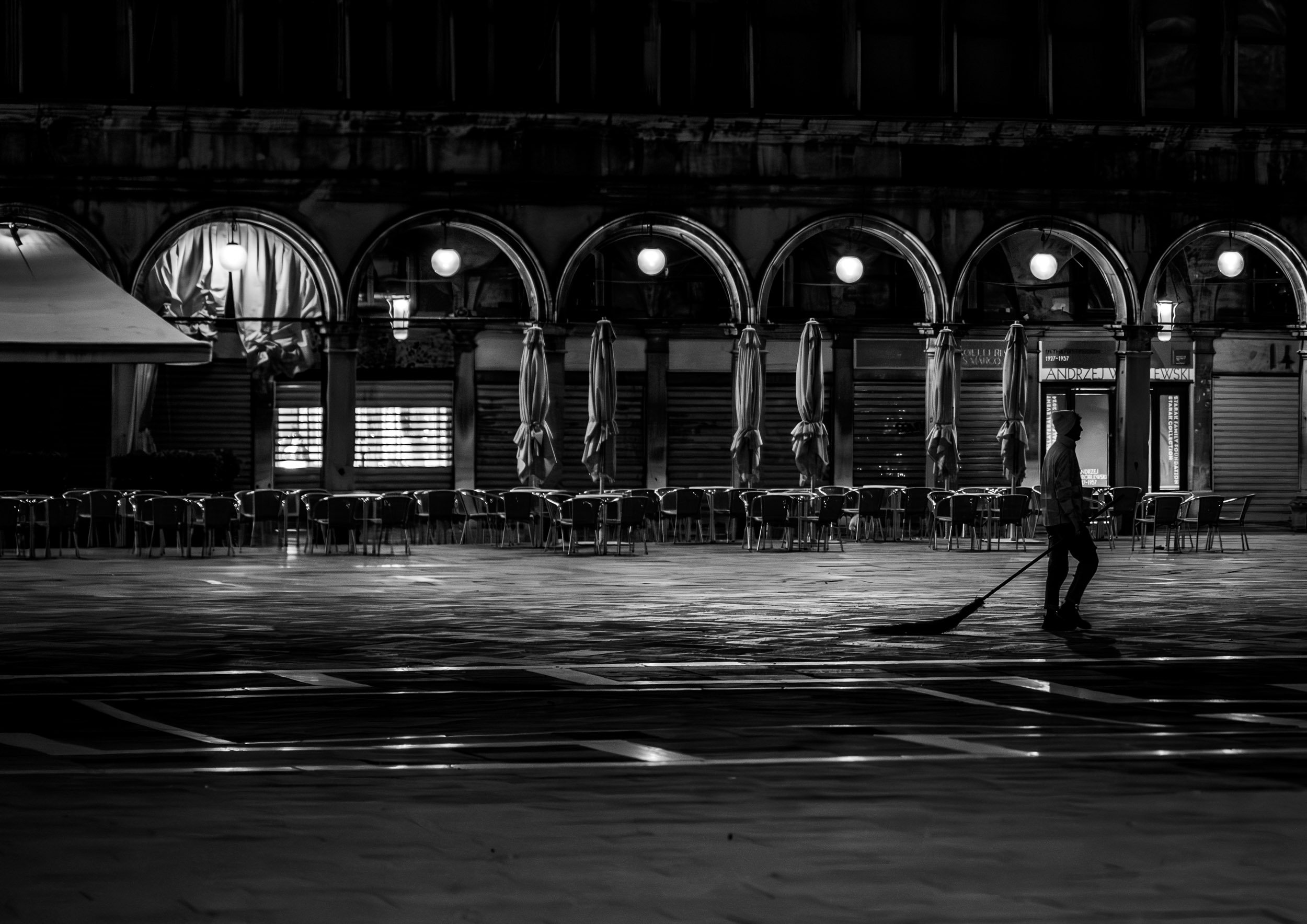Street Photographer Interview #2: Dan Waller
Hot on the heels of last week’s interview is another - this time with Dan Waller. Dan has been on numerous workshops with me - the last two being the ‘Monochrome Masterclass’ in Venice. As a result of those workshops, Dan has self-published a book and below is his story.
1/ How did you get started as a street photographer - and why? Tell us about your journey . . .
I grew up around photography. My grandfathers were both Polaroid fans, so, much of my childhood is documented in now-faded, square-formatted instant pics. I’ll always remember the magic, though, of those images appearing slowly. My Dad had his own darkroom in our attic and, because of his enthusiasm, I always had a camera growing up, though it was mainly used for holiday snaps.
Even though I’ve fully embraced digital, I still have the analogue mindset of being precious with my photos, harking back to the days of having a roll of just 24 exposures. For a while, though, I felt a bit stuck in a rut with my photography, as my camera was set on auto and I did not understand manual settings, or, more importantly, the joy that comes with the creativity of varying those settings. It was around the time I started taking photography more seriously that I discovered street photography. I particularly loved the idea of capturing ephemeral moments that could never be captured again.
I bought my first ‘grown up’ camera, Fuji’s X-T30, specifically because it was recommended for street photography, as it was small, discreet and easy to use. I have to credit Simon Ellingworth, whose Soho street photography workshop really got me started on my journey; the RPS, who have encouraged me to grow my photography skills; and you, Brian, particularly for your Saul Leiter workshop, which unshackled me from the necessity of capturing a decisive moment.
2/ How would you describe your photographic style?
I love using monochrome and I prefer high contrast images with crushed blacks. I want to show you the world differently, which is why I usually avoid shooting in colour or at eye level. I’m not interested in an accurate replication of the world and, ideally, I want you to feel something when you look at my photographs. Having said that, I deliberately chose to shoot in colour for my ARPS project, Soho at Night.
I wanted to utilise a digital submission and I thought the Soho neons would look best in colour. Plus, if you’re doing a long-term project like that, where you’ll be taking hundreds of photos in the same place for months, it’s not a bad idea to deliberately push yourself out of your comfort zone, in order to keep things interesting for yourself. One of the most helpful things you prompted, Brian, on my first Venice trip with you, was to ask myself what kind of street photographer I was. It was a revelation to acknowledge that I was an ‘aesthetic’ street photographer and that I particularly sought out beautiful images.
3/ Tell us about your new book: where did the idea come from? Why Venice? Why black & white?
I’m a big horror film fan, so ‘Death in Venice’ was a big influence. I loved how Venice could look both beautiful and menacing, particularly after dark. Even its decay seems to be artistic - exposed brickwork and rusted railings, which anywhere else would look grim, are somehow stunning in Venice. I wanted my book to take you on a journey from sunrise to sunset and to explore the darker, more mysterious side of Venice. I primarily shoot in black and white but I suspected Venice would look particularly glorious in monochrome. I actively sought out interesting light and textures. The book is a collection of more than a hundred of my photographs from my trips to Venice in November 2023 and 2024, including footage from two 3-day Masterclasses with Brian.
4/ How did you find making a book? What was the process? Did you encounter any difficulties?
I created a digital book after my first trip to Venice using the simple Lightroom/Blurb Books module but I never physically produced it because I found the layout options too restrictive. I kept compromising with the design and ultimately it just did not look the way I had envisaged.
I decided the best thing to do was to make use of Adobe’s InDesign but I needed the help of my partner to get my head around the programme and, ultimately, other projects ended up getting in the way. After my latest trip to Venice, I began by pooling my favourite photos in Lightroom. I knew that I wanted to print in landscape, with the dominant right hand page either for full page landscape images, or large portrait images. The left hand page could then be used for smaller, square format photos, predominantly for more intimate, close-up images, such as carnival masks, statues or architectural details. I found InDesign vital for ensuring images did not ‘bleed’ on to other pages and were correctly cropped to the page. Once I had the finished pdf from InDesign, it was then very easy to upload it to the publisher, Mixam.
5/ What gear do you use - and why?
When I failed my first attempt at the ARPS, I know it’s a cliché to blame one’s tools but I honestly realised that my kit wasn’t up to the rigours of night photography at Associate level. Shooting wide open, I just could not get the level of sharpness the RPS required. Consequently, I upgraded both my camera body, from my beloved Fuji X-T30 to the new Fuji X-T5, and my 50mm compact prime to Fuji’s new 56mm f1.2 ultra-fast prime. It’s perhaps an unusual choice for a street photographer but the 56mm (cropped sensor) hardly ever leaves my camera. Indeed, I took an assortment of prime lenses on my last Venice trip and I did not change it once. I honestly love that lens - particularly in low light, it creates such beautifully detailed images.
6/ If you could spend the day shooting with one photographer, dead or alive, who would it be?
Daido Moriyama. His fast-moving, speed-taking technique is completely the opposite of my own but I just think it would be fascinating to see what draws his eye.
7/ What single thing would improve your street photography ?
Patience! I do ‘fish’ (far more than I hunt) but I recognise that my patience threshold is pretty low. With my Soho at Night project, I got over it by revisiting the same scenes on different nights. I often knew that there was a picture to be had but I just wasn’t prepared to wait for the right person to come along. In Venice, I didn’t have the luxury of going back on a regular basis. So, I did wait about an hour one day, opposite a beautiful arch near the fish market. But I became so frustrated by people lingering on the bridge, through the arch, that eventually I just had to go and it was before getting the photo that I really wanted. The picture that made it into the book is nice but, in my heart, I know that there was a better one to be had, if only I could have been more patient!
8/ What are your views on analogue / film photography? Do you shoot film - or do you plan to? If not, why not?
I won’t lie, I love the ease and versatility of digital. Having grown up with analogue, I now like being able to see and edit my photos instantly and I enjoy playing with them in Lightroom, in ways that I never could have imagined as a boy. My Dad has some beautiful analogue cameras and he expresses some sadness that I do not seem interested in them but I think there will come a time when I would actually love to experiment with them. I’ve recently been playing with Analogue Efex and I can certainly appreciate the joy of quirky, analogue lenses and the different ways of processing film.
10/ How can people buy a copy of the book?
My book, ‘Venice in Silver’, is available direct from the publisher, Mixam, for £20 via the link https://mixam.co.uk/print-on-demand/675078cd62d5252a5e16fe52. I really appreciate the support from the StreetSnappers community and I really hope you all enjoy the book. I hope it inspires some of you to visit Venice for yourself - it is a street photographer’s dream!
Bonus question: Spritz or Negroni?
Tough question but I’m going to say Spritz Select. Nothing rekindles Venice memories as powerfully as Select! [Note from Brian: he did have a few!!]
You can use the links below to follow Dan on Instagram, see his website and buy the book:
Instagram @chacarunadan
Website www.chacaruna.net
Buy the book via Mixam publishing link https://mixam.co.uk/print-on-demand/675078cd62d5252a5e16fe52
My next Monochrome Masterclass workshop will take place next November and I’ll be announcing the dates early in January - watch this space. I can also organise one-to-one workshops throughout the year - either for individuals or a small group of friends. All the details are here.





